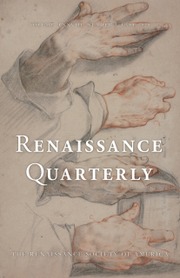This heterogenous collection of essays is divided into sections devoted to metamorphoses, human-animal relations, and the monstrous. In the first section, Robert Sturges describes representations of Merlin, offspring of Satan and a nun, as a “boundary crosser in several senses” (4), sometimes assuming the form of a stag, boar, or hairy wild man. In Sturges’s well-culled examples, Merlin’s permutations unleash tensions between the demonic and the divine. The figure’s varied manifestations, with all their strange and circumstantial meanings, make for lively reading and seem an appropriate entrée into the varied subjects of this tome. Engaging a theologian’s view, Edit Anna Lukacs’s essay revisits Thomas Bradwardine’s fourteenth-century De Causa Dei to highlight his analogies of Mary’s immaculate conception with animal auto-conception (horses impregnated by the wind and partridges by certain smells) and to demythologize human metamorphoses into animals as proof of God’s even greater power to transform dead bodies at the time of Resurrection. Lukacs helpfully dissects Bradwardine’s logic and categorical distinctions. Other essays consider particular creatures, including John Nassichuk’s chapter analyzing the doves, pigeons, and owls in Nicolas Brizard’s Metamorphoses Amoris (1556). Nassichuk’s essay is essential to anyone interested in Cupid’s iconography in late sixteenth-century France, since even court poets seem to have looked to Brizard’s primer on Greek vocabulary. Readers discover the clever, Protean guises Cupid could assume, and Nassichuk navigates the terrain sensitive to both symbolic images and the lexical semantics of his sources.
After the grouping of essays on metamorphosis, the second section considers human mastery of beasts. Susan Anderson analyzes a thirteenth-century English bestiary (Bodley MS 764) whose violent portrayal of a boar hunt reveals deeper struggles among patron and audience concerning beliefs about gender, ethnicity, class, and species. Pairing close visual analysis with citations to Celtic and Welsh lore, Anderson succeeds in illuminating the patron’s battle with mixed ethnicity, ideological order, masculine pretense, and class hierarchy. The reader emerges with a deeper reading of this unusually graphic human/beast struggle in a paradoxical age in which a boar could allude to Welsh kings, noble animal adversaries, and natural danger, but also to gluttony and uncleanliness (the latter hatefully conjoined with antisemitic fears). The theme of human mastery over beasts continues with Kathryn Renton’s essay on Spanish horsemanship and Libros de Jineta. She contrasts the authorial ambitions of the Cordoban noble Luis Bañuelos de la Cerda, whose 1605 treatise predictably equates noble birth with good horsemanship, and those of Pedro Fernández de Andrada (treatise 1599), who argues the caballerizo (stable master) can acquire an element of nobility through the practice of expert horsemanship. Despite asserting competition among cultural values and social meanings of horsemanship, the essay is short on precise examples. One also longs for the meaningful differentiation of these two books from the many similar manuals from the period.
In part 3, titled “Beyond Humanity: Demons and Monsters,” David Scott-MacNab revisits the much-debated circumstances of King William II of England’s death as told by a mid-twelfth-century writer, Walter Map. Map mentions a “noonday demon” (112) that, as MacNab proves, is not the traditional sin of acedia (sloth) as some would have it, but rather a beguiling hunter demon with the blinding brilliance of Satan who ensnares the king and leads him away from the protections of God’s grace promised in Psalm 90. Alongside modern interpretations of political jockeying around William II’s mysterious death, MacNab identifies a significant interpretive change in the providential narrative. The theme of psalms and devilish torment continue in Amanda Downey’s study of illuminations of the Temptation of Christ from between 1150 and 1400. General readers and undergraduates will find an enticing survey of comic and aggressive visual conventions of the devil. However, few conclusions are offered about what this small sample of English and French psalters, books of hours, and breviaries reveal when compared to the myriad other devil portrayals in other chronologies and sources. On a rather different subject, Rachel Chantos suggests the fad for carved grotesques on cassoni (marriage chests) in late sixteenth-century Central Italy is linked to anxiety over the dangers of pregnancy and laxity about the sacramental character of marriage. Unfortunately, no patron’s or artist’s voice is quoted, nor any language from girls’ primers to support the thesis. One is left to wonder, for example, how grotesques might have squared with the rising fascination with monstrous births during the period. The volume’s final essay, by Thomas Willard, surveys Paracelsus’s understanding of monsters across his many writings, offers useful schema of classification, and notes the prevalence of Paracelsian neologisms in the earliest English-language descriptions of supernatural phenomena. This essay would make appropriate assigned course reading, as, indeed, this eclectic collection of essays would be a meaningful library addition on topics of metamorphosis, human/animal relations, and monstrosity.


